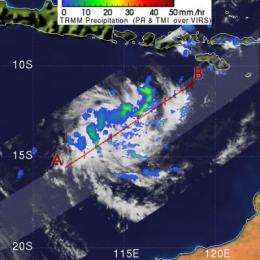91S becomes Tropical Cyclone 24S as NASA's TRMM captures its rainfall

NASA's Tropical Rainfall Measuring Mission or TRMM satellite has been flying over the low pressure area known as System 91S in the Southern Indian Ocean and providing estimates of rainfall within the storm. The storm has now strengthened enough to be reclassified as the twenty-fourth southern hemispheric tropical cyclone, "24S."
TRMM, managed by NASA and the Japanese Space Agency (JAXA) passed over System 91S early today, April 22 at 3:08 Eastern Daylight Time (0708 UTC) and captured a look at the rainfall rates in the storm. TRMM found that there were some areas of light to moderate rainfall between .78 to 1.57 inches per hour.
Rain rates are created from different instruments aboard TRMM. The rain rates in the center of TRMM images are derived from the TRMM Precipitation Radar, the only space borne radar of its kind, while those in the outer portion are from the TRMM Microwave Imager. The rain rates are then overlaid on infrared data from the TRMM Visible Infrared Scanner to create the entire image. The images are created at NASA's Goddard Space Flight Center, in Greenbelt, Md.
At 11 a.m. EDT (1500 UTC) this morning, April 22, Tropical Cyclone 24S had maximum sustained winds near 35 knots (40 mph) making it of tropical storm strength. 24S was about 570 nautical miles north of Learmonth, Australia, near 13.1 South and 115.4 East. It was moving in a southerly direction at 6 mph (5 knots) but it is forecast to turn westward and head into open waters and away from Australia.
Animated infrared satellite imagery shows increased central convection (thunderstorm development) and improved banding of thunderstorms around the center of the cyclone. Because 24S is in an environment of low vertical wind shear, it is expected to further intensify for a couple of days. After that, the wind shear will kick up again and weaken the storm.
Provided by NASA's Goddard Space Flight Center



















